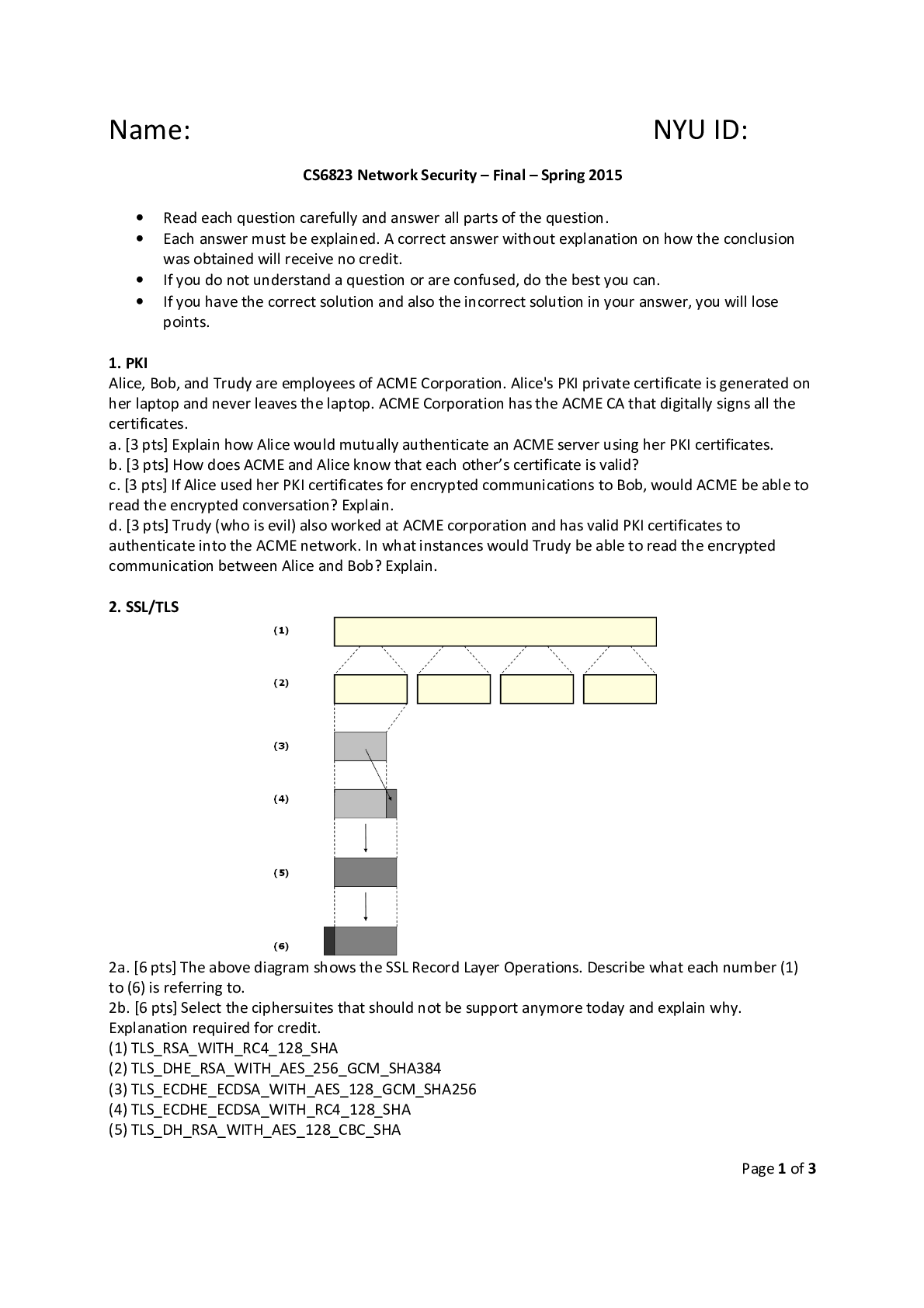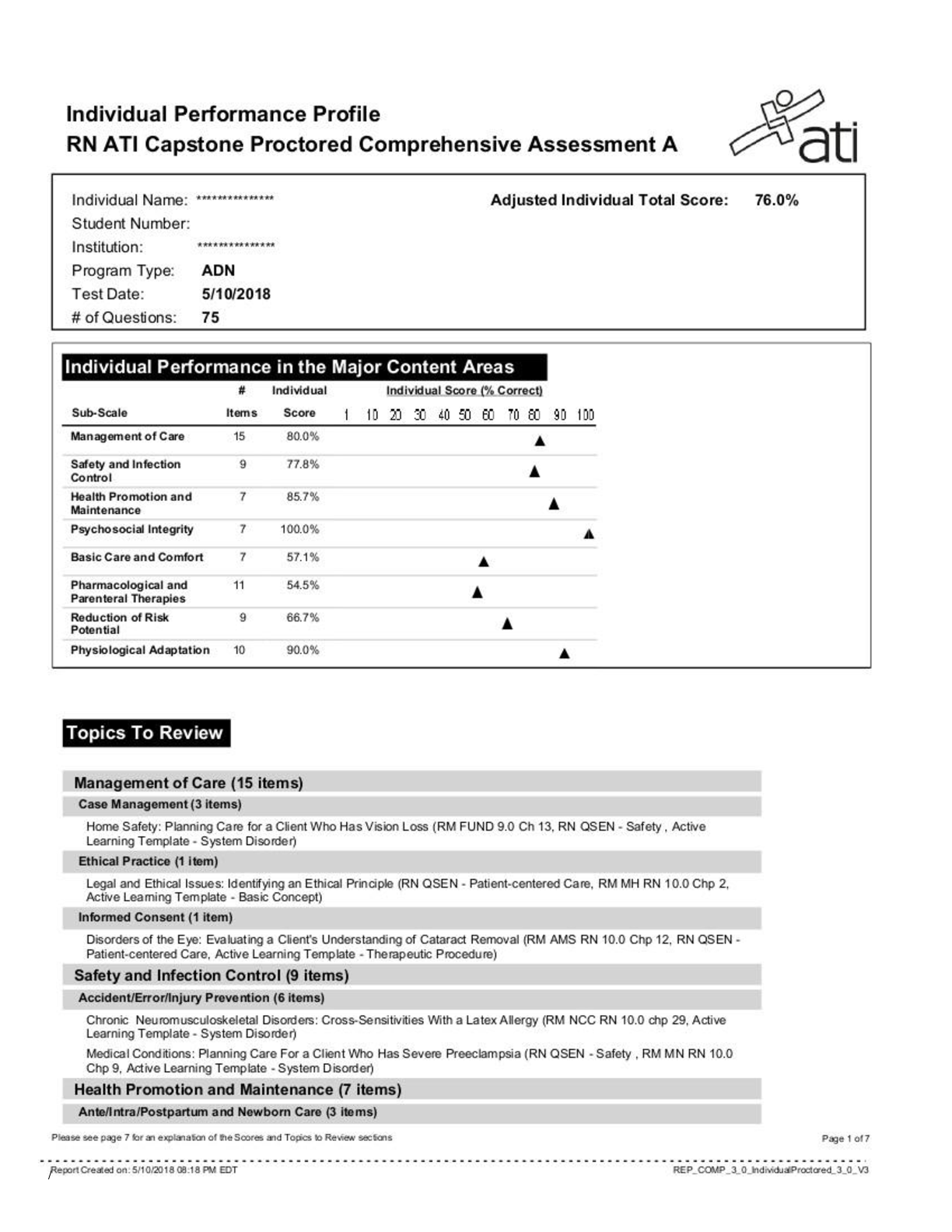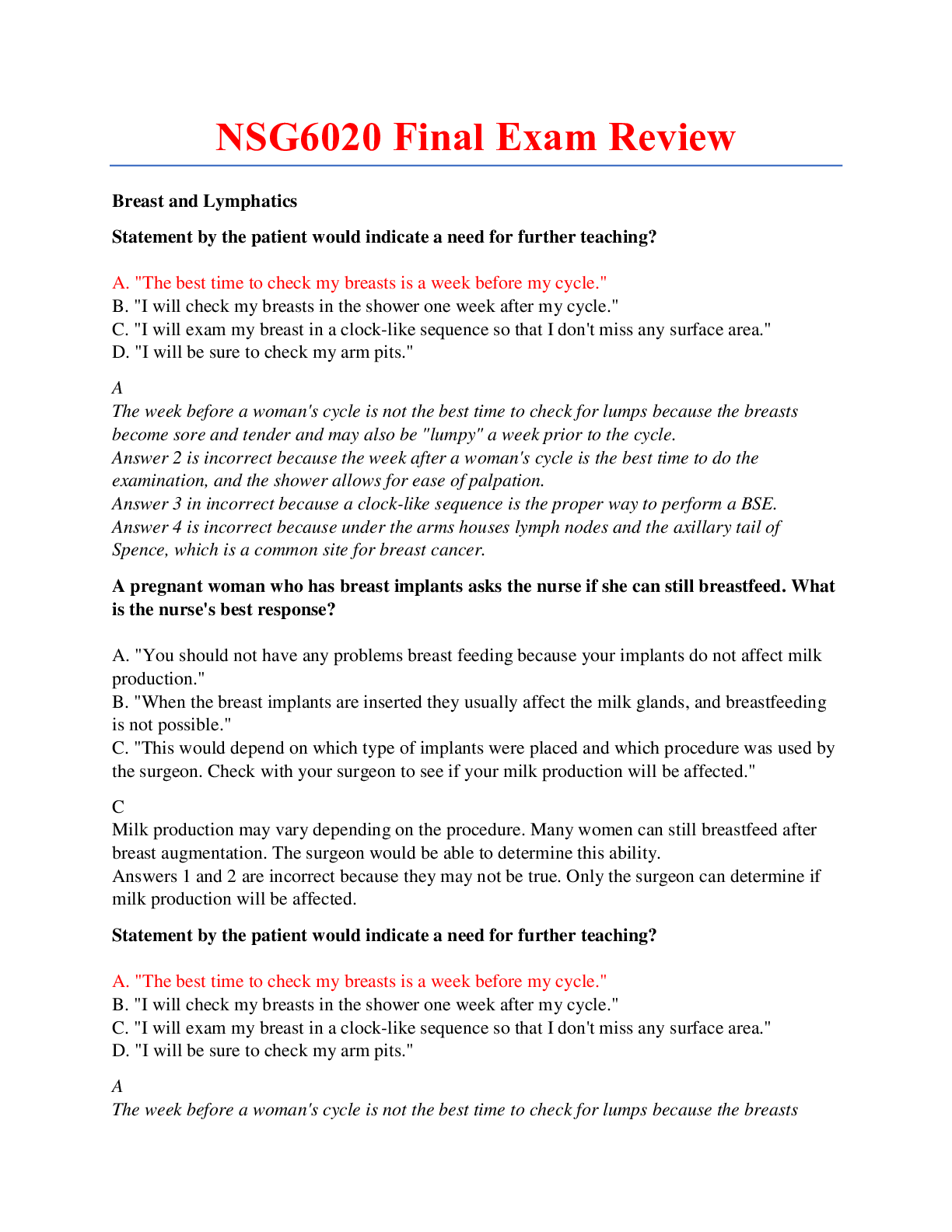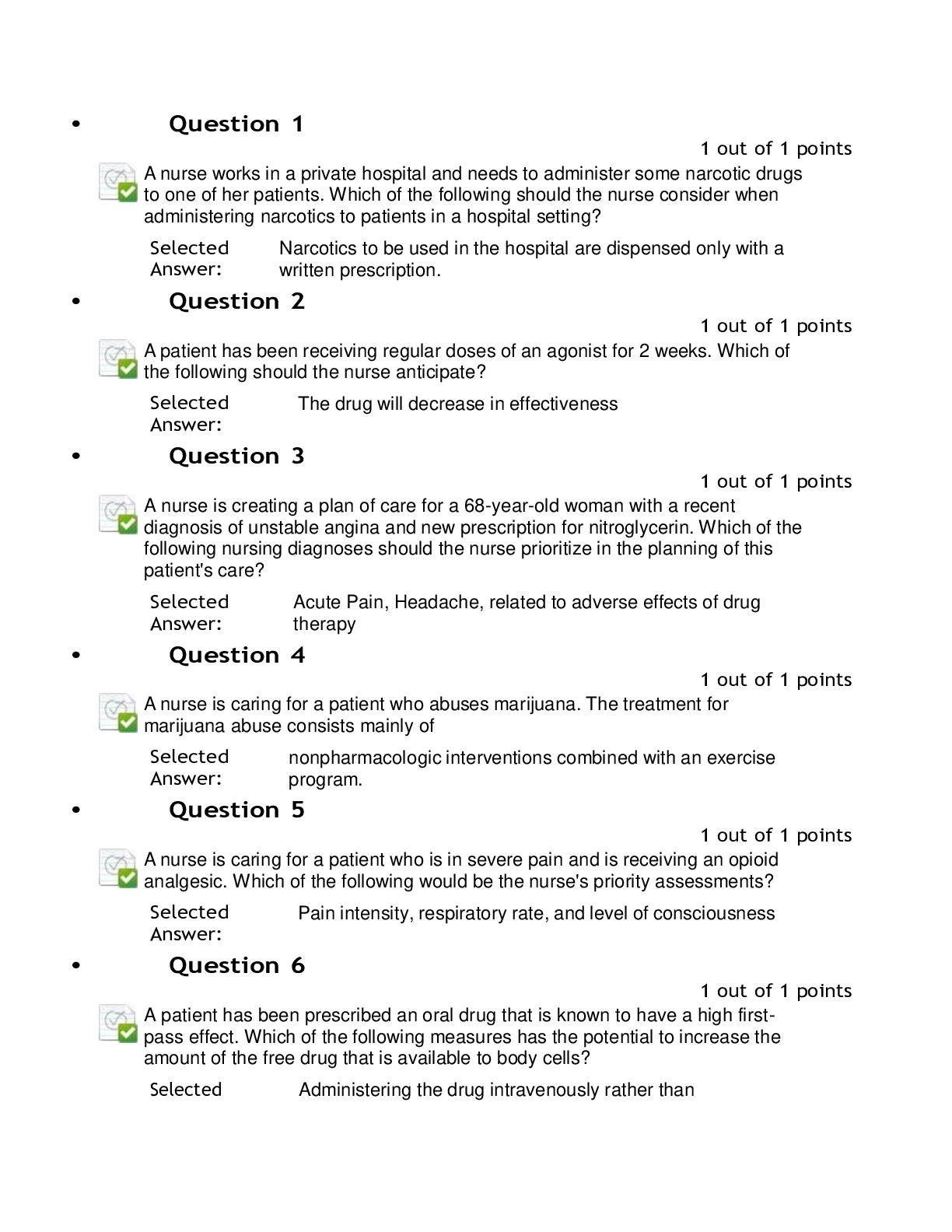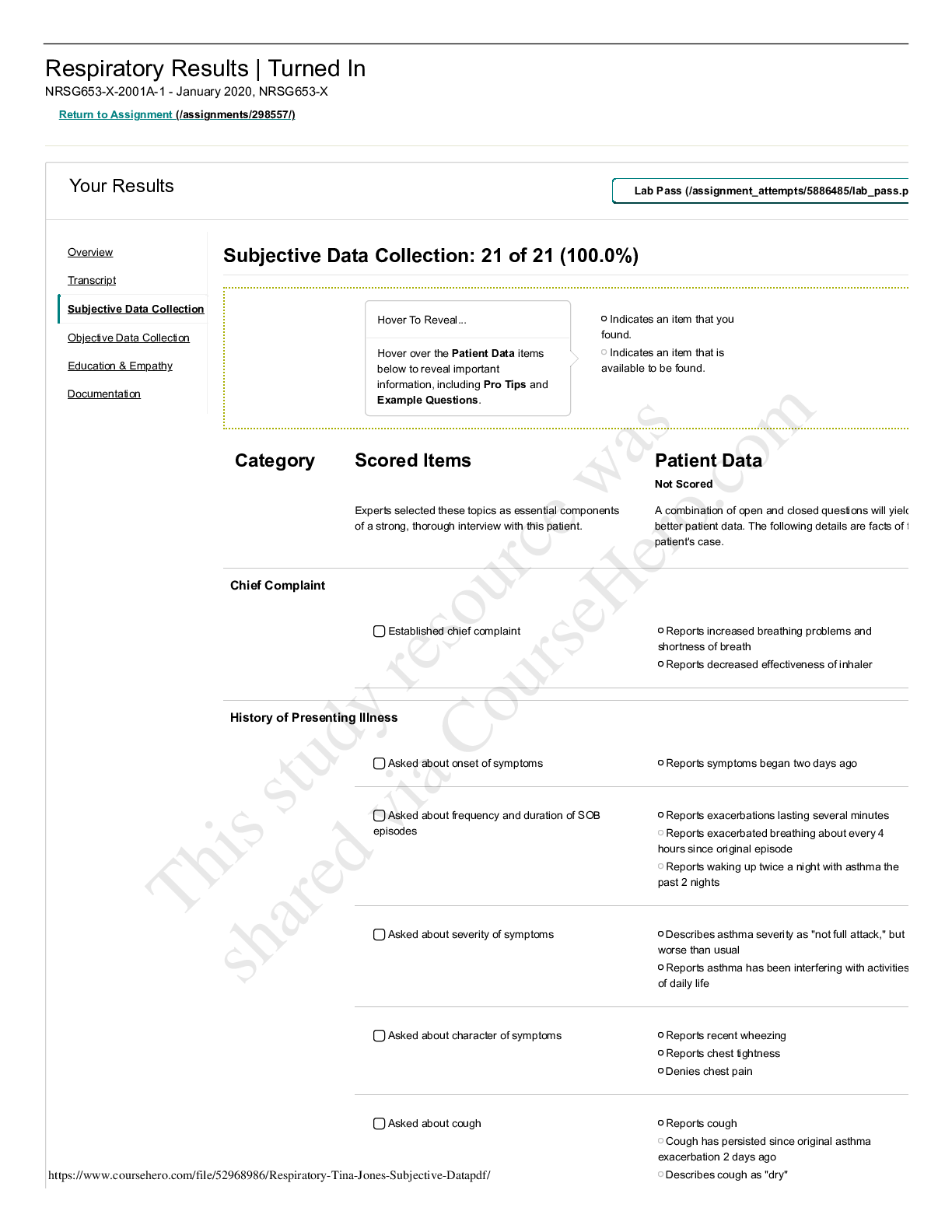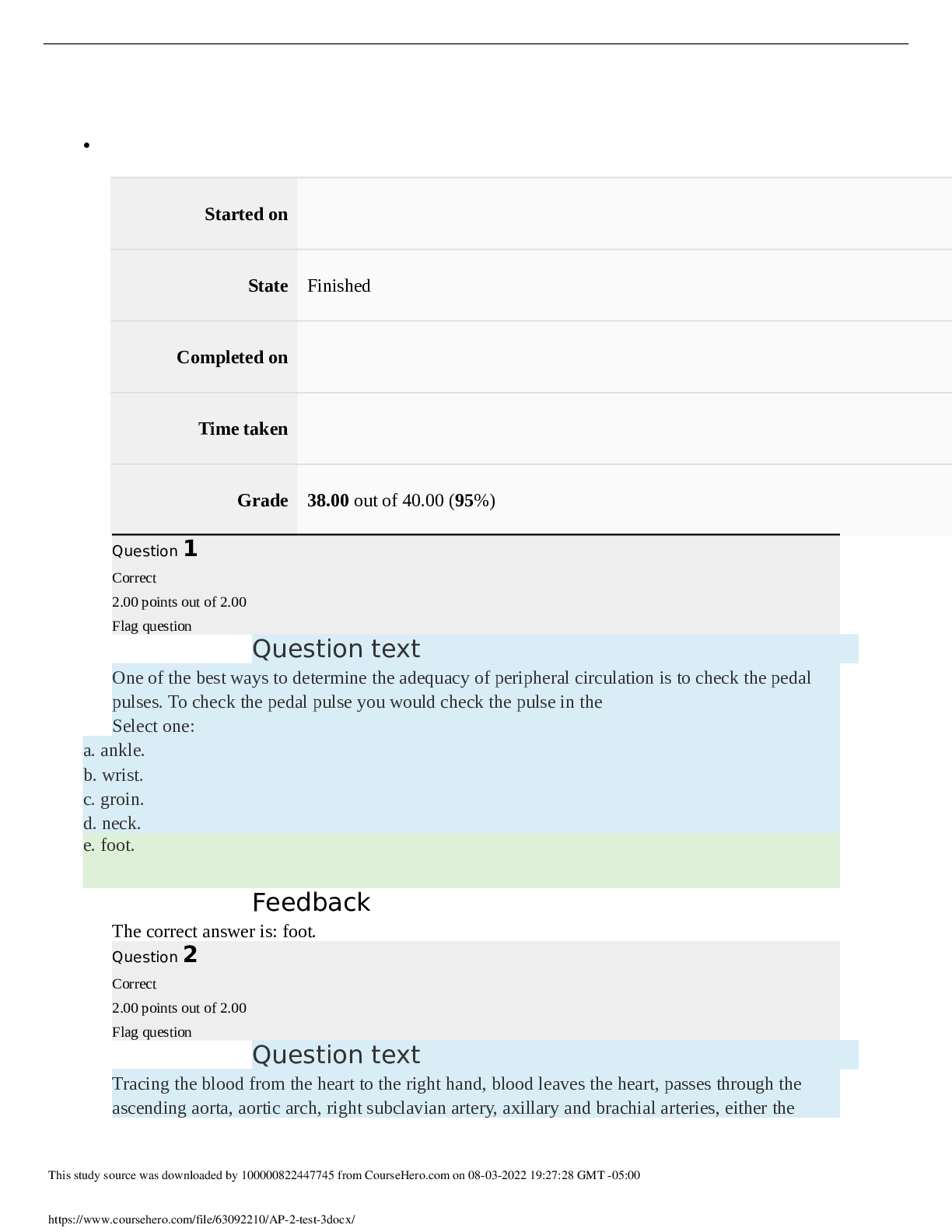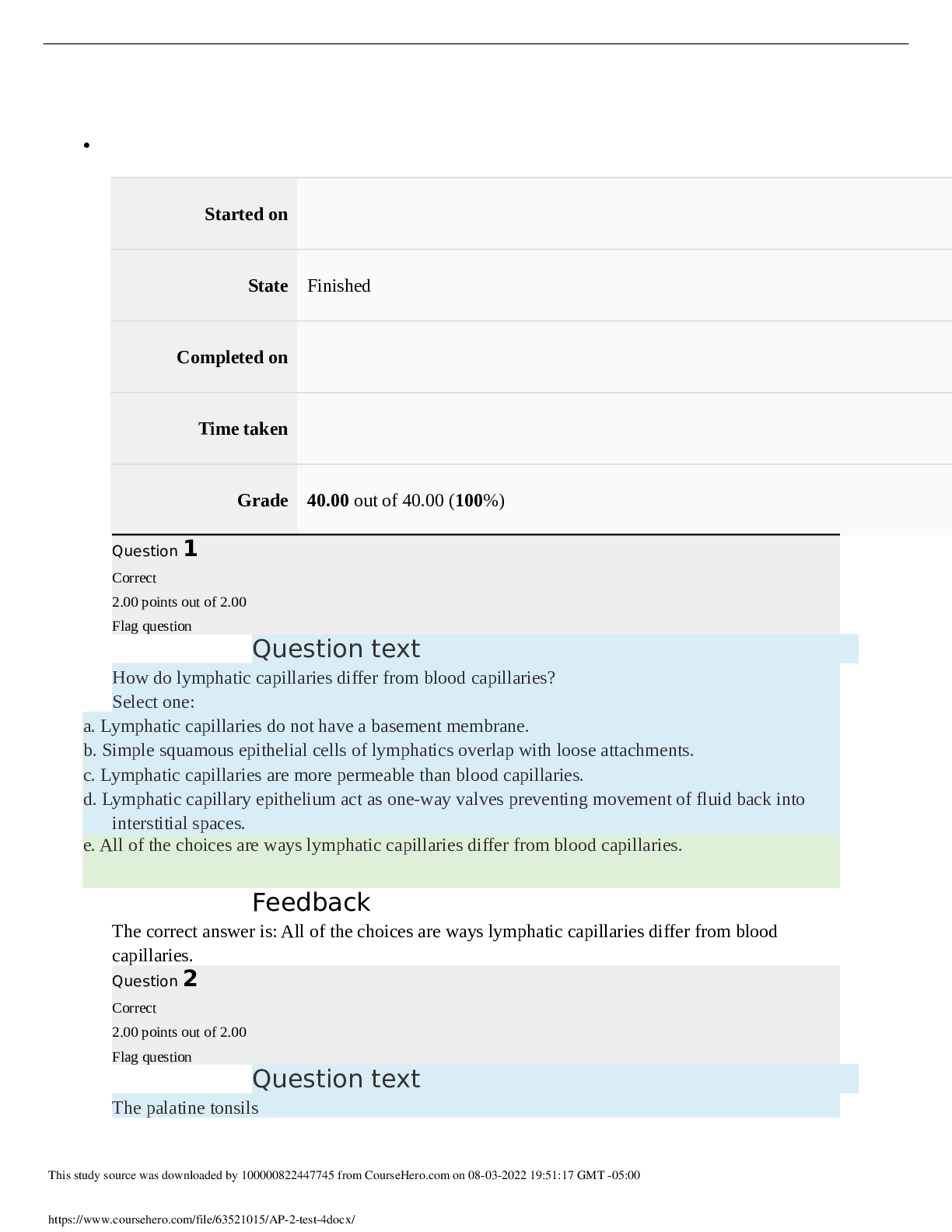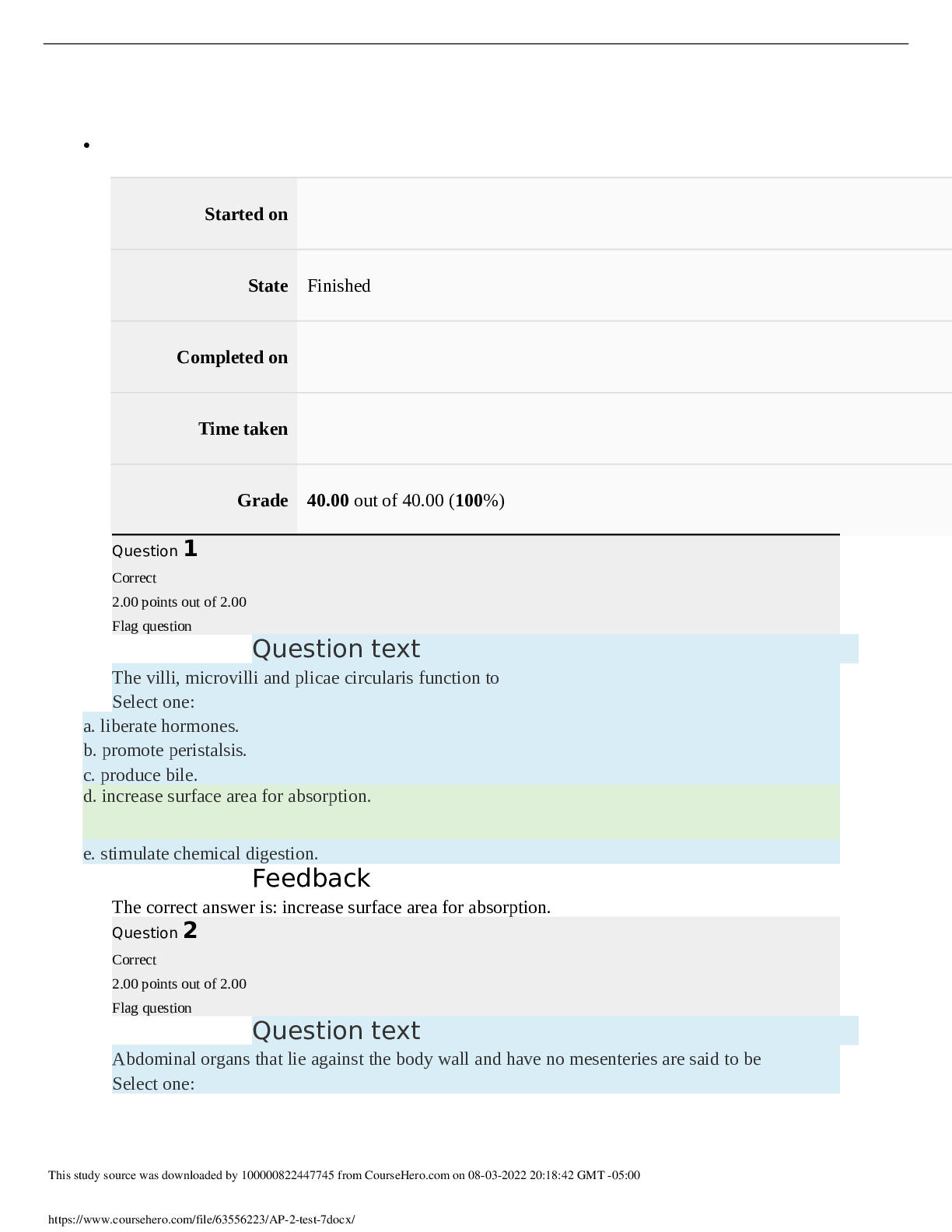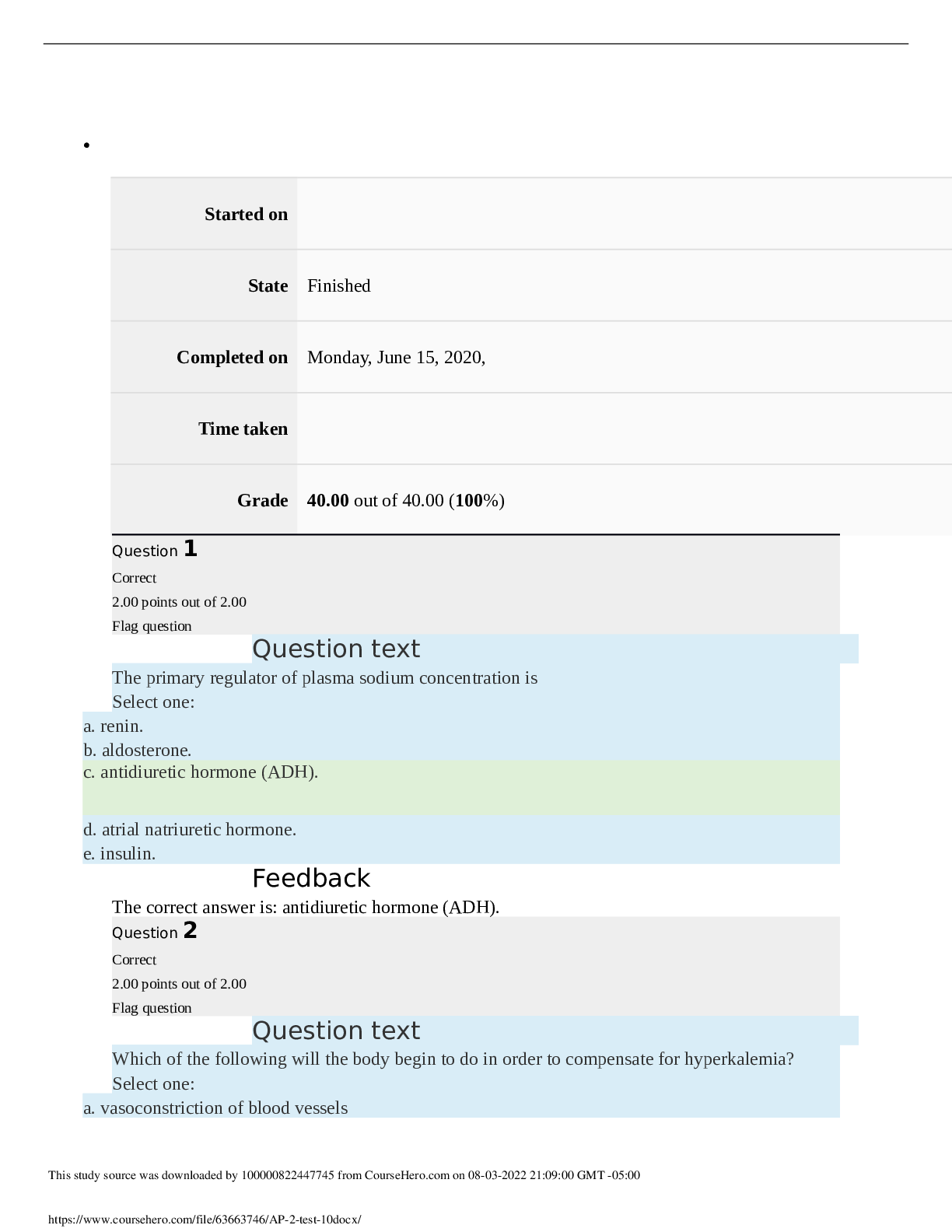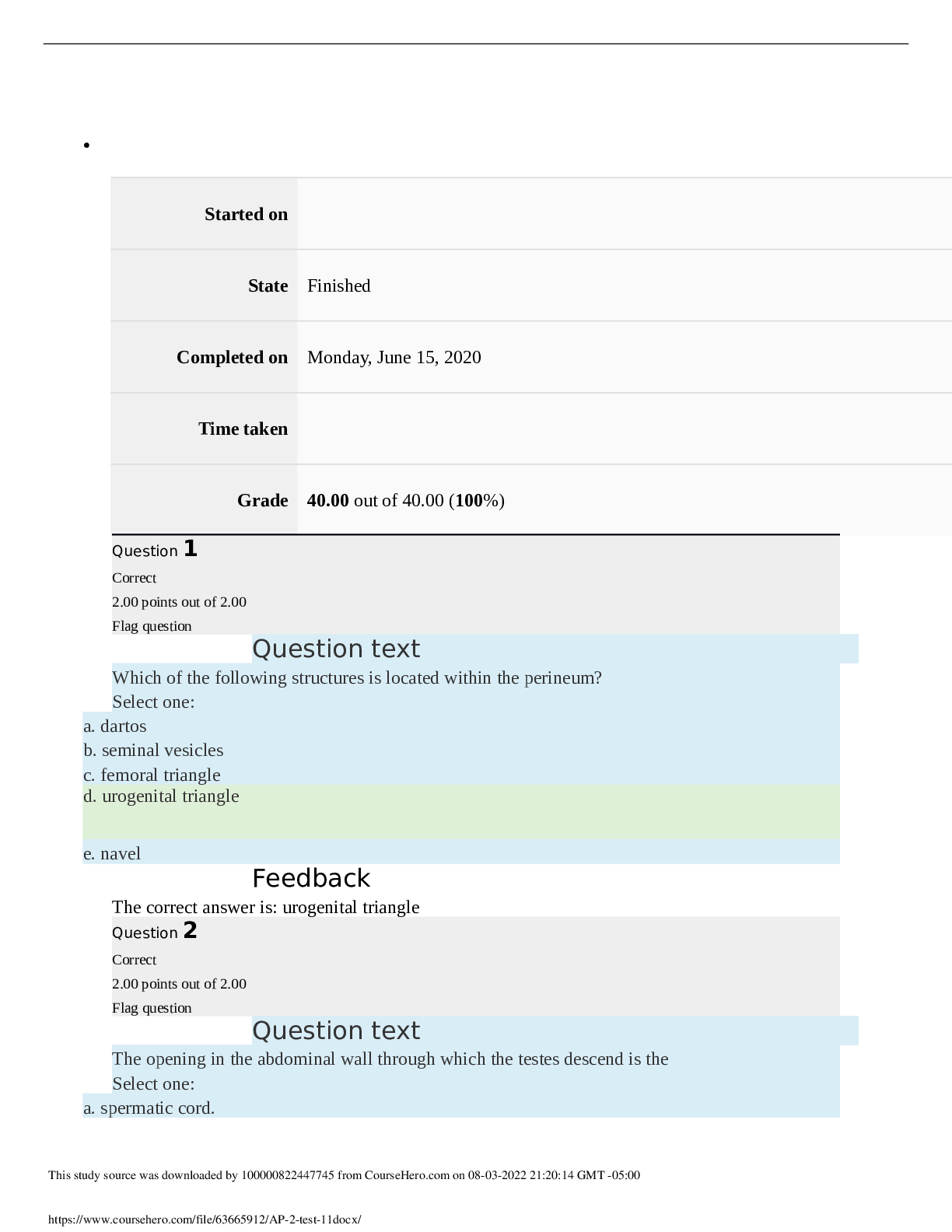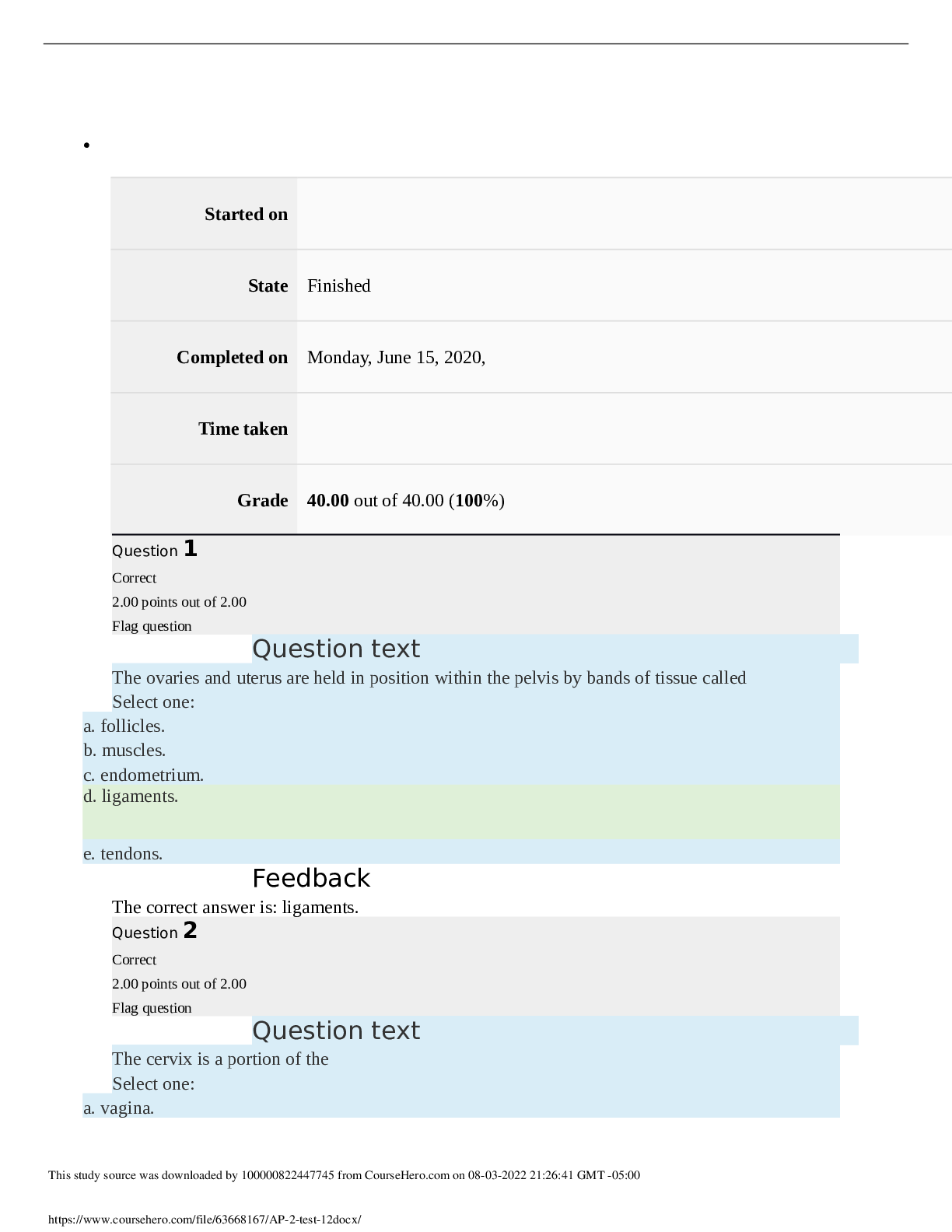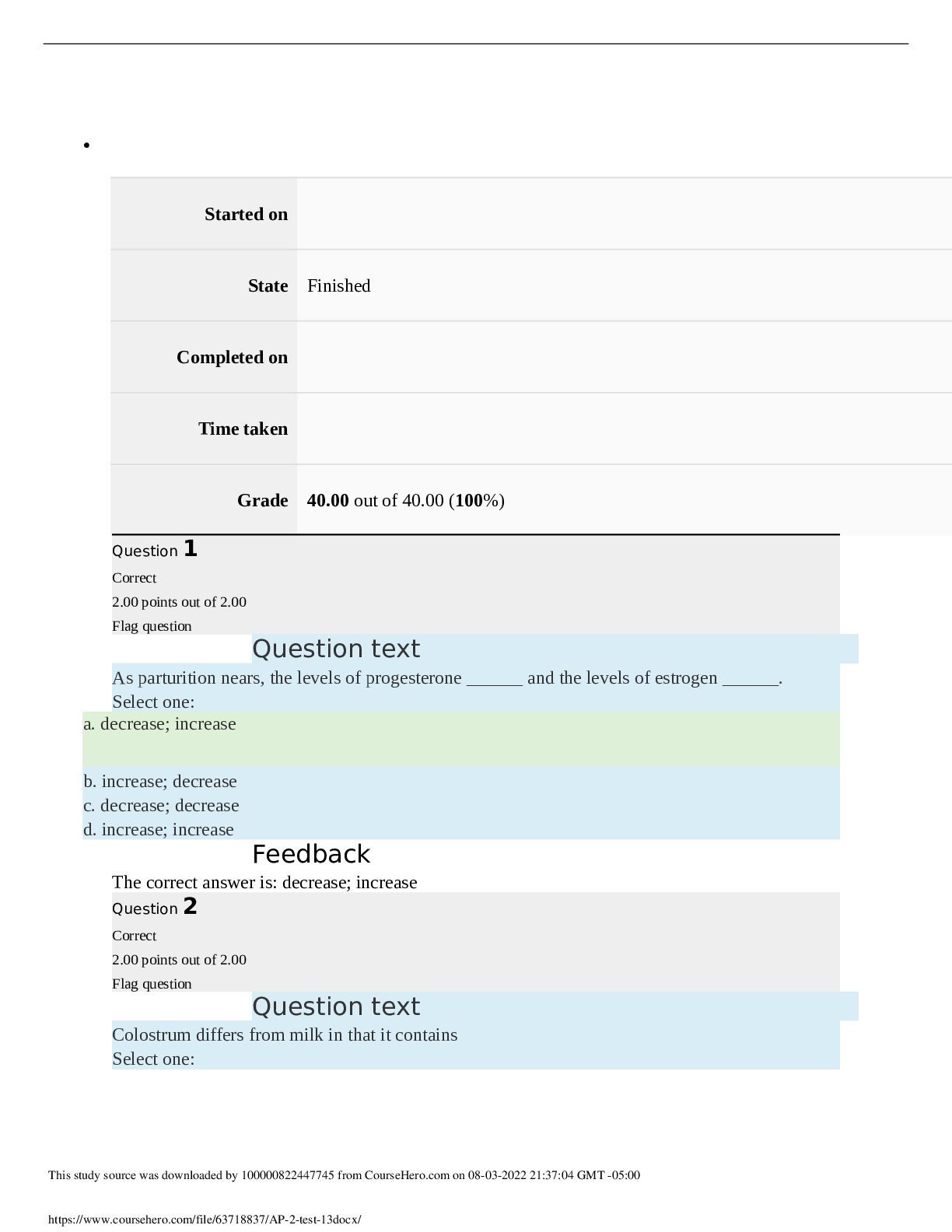Anatomy and Physiology - A&P 2 > EXAM > Straighterline AP2 202 Anatomy & Physiology 2 A&P 2 Test 2. Grade 38.00 out of 40.00 (95%) (All)
Straighterline AP2 202 Anatomy & Physiology 2 A&P 2 Test 2. Grade 38.00 out of 40.00 (95%)
Document Content and Description Below
Started on State Finished Completed on Time taken Grade 38.00 out of 40.00 (95%) Question 1 Flag question Question text Ventricular contraction begins at the Select one: a. AV bundle. b... . apex of the heart. c. base of the heart. d. superior portion of the interventricular septum. e. top of the ventricles. apex of the heart. Question 2 Flag question Question text Chemoreceptors sensitive to blood oxygen levels are primarily located in the Select one: a. medulla oblongata. b. carotid arteries. c. right atrium. d. left ventricle. e. jugular veins. carotid arteries. Question 3 Flag question Question text When comparing cardiac muscle cells and skeletal muscle cells, Select one: a. the rate of action potential propagation is faster in cardiac muscle. b. both possess intercalated discs. c. only skeletal muscle has a plateau phase in its contraction cycle. d. action potentials are conducted from cell to cell only in cardiac muscle. e. both are voluntary. action potentials are conducted from cell to cell only in cardiac muscle. Question 4 Flag question Question text The period of isovolumetric contraction is immediately followed by Select one: a. the period of ejection. b. AV node depolarization. c. passive ventricular filling. d. atrial contraction. e. isovolumetric relaxation. the period of ejection. Question 5 Flag question Question text Blood in the pulmonary veins returns to the Select one: a. right atrium. b. left atrium. c. right ventricle. d. left ventricle. e. coronary sinus. left atrium. Question 6 Flag question Question text Regurgitation of blood flow through the aortic semilunar valve would give rise to Select one: a. the first heart sound. b. the second heart sound. c. a heart murmur. d. an extra heart beat. e. end-systolic volume. a heart murmur. Question 7 Flag question Question text The product of the stroke volume times the heart rate is known as the Select one: a. end-diastolic volume. b. end-systolic volume. c. cardiac output. d. cardiac reserve. e. venous return. cardiac output. Question 8 Flag question Question text The action potentials are slowed at the AV node to allow the Select one: a. ventricles to repolarize. b. ventricles to completely empty of blood. c. pacemaker to reset for the next beat. d. atria to complete their contraction. e. atria to begin their contraction. atria to complete their contraction. Question 9 Flag question Question text The dicrotic notch in the aortic pressure curve is due to the Select one: a. increase in intraventricular pressure during ejection. b. backflow of blood toward the ventricles. c. closure of the left AV valve. d. elasticity of the arterial wall. e. closure of the semilunar valves. backflow of blood toward the ventricles. Question 10 Flag question Question text Which of the following would result from a reduced function of the sodium channels in the SA node? Select one: a. depolarization would be delayed b. the heart rate would decrease c. repolarization would not occur d. a shortened plateau phase e. depolarization would be delayed and the heart rate would decrease depolarization would be delayed and the heart rate would decrease Question 11 Flag question Question text During hemorrhagic shock in which blood pressure is decreased, which of the regulatory mechanisms is most important is increasing cardiac output to help maintain blood pressure? Select one: a. increased sympathetic stimulation of the heart b. increase venous return c. increase in parasympathetic stimulation of the heart d. increase vagal stimulation of the heart e. increase in the amplitude of the heart sounds increased sympathetic stimulation of the heart Question 12 Flag question Question text A patient has been diagnosed with mild heart disease. Tests show that some of the coronary arteries are partially occluded. Which of the following is the best course of action to treat the disease? Select one: a. Angioplasty b. Coronary bypass surgery c. Electrocardiogram d. Tissue plasminogen activation e. Angiogram Angioplasty Question 13 In 0.00 points out of 2.00 Remove flag Question text In the cardiac cycle, Select one: a. the right atrium and the right ventricle contract simultaneously. b. the left atrium contracts before the right atrium. c. all four chambers of the heart contract at the same time. d. all four chambers of the heart are in diastole at the same time. all four chambers of the heart are in diastole at the same time. Question 14 Flag question Question text An incompetent pulmonary semilunar valve could result in less blood reaching the Select one: a. lungs. b. heart muscle. c. right ventricle. d. aorta. e. right atrium. lungs. Question 15 Flag question Question text Coronary artery disease can diminish myocardial blood flow resulting in the death of myocardial cells. This condition is known as a myocardial Select one: a. attack. b. angina. c. necrosis. d. cirrhosis. e. infarction. infarction. Question 16 Flag question Question text Variations in respiratory rate is a symptom of Select one: a. sinus arrhythmia. b. ventricular tachycardia. c. SA node block. d. paroxysmal atrial tachycardia sinus arrhythmia. Question 17 Remove flag Question text Angina pectoris is chest pain caused by reduced Select one: a. stimulation of the myocardium. b. blood supply to cardiac muscle. c. fluid in the pericardial sac. d. contractility of the heart. e. action potentials from SA node. blood supply to cardiac muscle. Question 18 Flag question Question text Aortic stenosis results from Select one: a. a hole in the interatrial septum. b. a weakening of heart muscle. c. a narrowed opening through the aortic valve. d. low oxygen levels. e. leakage from the AV valves. a narrowed opening through the aortic valve. Question 19 Flag question Question text Calcium channel blockers are frequently used to Select one: a. increase the heart rate. b. treat tachycardia or other arrhythmias. c. speed up conduction of impulses through the AV node. d. slow the closing of potassium ion channels. e. treat bradycardia and low blood pressure. treat tachycardia or other arrhythmias. Question 20 Flag question Question text Which of the following might increase the risk for cardiovascular disease? Select one: a. stopping smoking b. exercise c. maintaining normal cholesterol levels d. chronic stress e. lots of fiber in the diet chronic stress Finish review Skip Quiz navigation Quiz navigation [Show More]
Last updated: 1 year ago
Preview 1 out of 9 pages
Instant download

Buy this document to get the full access instantly
Instant Download Access after purchase
Add to cartInstant download
Reviews( 0 )
Document information
Connected school, study & course
About the document
Uploaded On
Aug 04, 2022
Number of pages
9
Written in
Additional information
This document has been written for:
Uploaded
Aug 04, 2022
Downloads
0
Views
122

